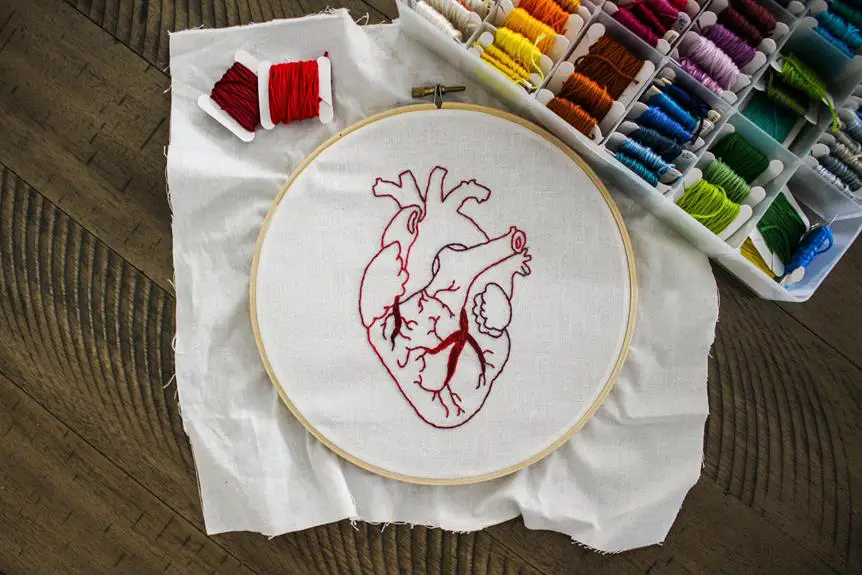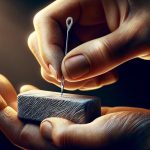Are you ready to take your embroidery to the next level?
Achieving quality embroidery requires attention to detail and mastering essential techniques.
In this guide, you'll discover seven tips that will elevate the quality of your embroidery work.
From selecting the right fabric to understanding design placement, each tip plays a crucial role in achieving professional results.
By implementing these tips, you'll gain the mastery and precision needed to create stunning embroidered pieces that stand out.
Let's dive into these essential tips and take your embroidery skills to new heights.
Key Takeaways
- Consider fabric weight, weave, and composition for optimal results
- Select needles designed for specific fabrics and threads
- Proper hooping ensures secure and even fabric placement for professional-looking embroidery
- Take garment curvature into account for proper placement of embroidery design
Selecting the Right Fabric
When selecting the right fabric for embroidery, consider the fabric's weight, weave, and composition to ensure optimal results. Quality materials are fundamental for achieving exceptional embroidery.
The fabric weight determines its thickness and density, influencing how the embroidery will sit on the fabric. Lighter weights are suitable for delicate designs, while heavier weights are better for more substantial designs.
The fabric's weave also plays a crucial role. A tight weave provides a stable base for embroidery, while looser weaves may require stabilizers to prevent distortion.
Additionally, understanding the fabric's composition is essential. Natural fibers like cotton and linen are popular choices due to their breathability and ability to hold stitches well. On the other hand, synthetic fabrics like polyester can offer durability and color retention.
Understanding these factors will help you make informed decisions when it comes to fabric selection for your embroidery projects. Equipped with this knowledge, you can confidently choose the right fabric for your embroidery techniques and ensure that the fabric care aligns with the materials chosen.
Choosing High-Quality Threads
To achieve high-quality embroidery, it's essential to select threads that complement the chosen fabric and enhance the overall design. When choosing threads for your embroidery projects, there are several important factors to consider:
- Thread Tension: Ensure that the threads you choose work well with your embroidery machine's tension settings. Different threads may require adjustments to achieve the perfect tension for a flawless finish.
- Color Matching: Select threads that closely match the colors in your design. Proper color matching will ensure that your embroidery looks vibrant and cohesive.
- Thread Durability: Opt for high-quality threads that are durable and can withstand the wear and tear that may occur during embroidery and subsequent use.
- Brand Comparison: Research and compare different thread brands to find ones that consistently receive positive feedback for their quality and performance.
Using the Correct Needles
Select needles that are specifically designed for the type of fabric and thread you are using in your embroidery project. Using the correct needles is crucial for achieving quality embroidery. Different needle types and sizes are designed to work with specific fabrics and threads, and using the wrong needle can lead to issues such as thread breakage, poor stitch quality, or fabric damage. Here's a guide to help you choose the right needle for your embroidery project:
| Needle Type | Fabric | Thread |
|---|---|---|
| Universal | Medium-weight | Cotton, polyester |
| Ballpoint | Knits, stretch | Rayon, polyester |
| Sharp/Microtex | Silk, microfiber | Silk, fine threads |
Choosing the correct needle type and size can help prevent issues such as skipped stitches, fabric puckering, or thread tension problems. For example, using a ballpoint needle on knit fabrics reduces the risk of fabric damage, while selecting the appropriate needle size for your thread can prevent thread breakage and ensure proper stitch formation. Understanding the relationship between needle types, sizes, and thread tension is essential for troubleshooting embroidery issues and achieving professional results.
Practicing Proper Hooping Techniques
To achieve quality embroidery, ensure proper hooping techniques by positioning the fabric securely and evenly in the embroidery hoop. Proper hooping is essential for achieving professional-looking embroidery. Here are some tips to help you practice proper hooping techniques:
- Hoop Tension: Adjust the tension of the hoop to ensure that the fabric is taut but not overstretched. Proper tension prevents puckering and ensures even stitching.
- Stabilizer Usage: Choose the right stabilizer based on the fabric and design. Stabilizers provide support to the fabric during the embroidery process, preventing distortion and enhancing the overall quality of the finished embroidery.
- Hoop Size: Select the appropriate hoop size for the design and fabric. Using a hoop that's too small can cause the fabric to bunch up, while a hoop that's too large may not hold the fabric securely.
- Fabric Thickness: Consider the thickness of the fabric when hooping. Thicker fabrics may require additional stabilizer or adjustments to the hoop tension to ensure smooth and precise embroidery.
Mastering Essential Stitching Techniques
Mastering essential stitching techniques involves understanding the role of the needle and thread in creating precise and intricate embroidery designs. One crucial aspect to master is thread tension. Proper thread tension ensures that the stitches are neither too loose nor too tight, resulting in a balanced and professional-looking embroidery. Adjust the tension according to the type of fabric and thread being used for optimal results.
Another important technique to master is stitch density. Stitch density refers to the spacing and arrangement of stitches within a design. It's essential to achieve the right stitch density to ensure that the design looks uniform and well-defined. Experiment with different stitch lengths and densities to find the ideal combination for the specific design and fabric you're working with.
Understanding Design Placement
When it comes to achieving quality embroidery, understanding design placement is crucial. Proper fabric alignment and considering garment curvature are key points to keep in mind.
Proper Fabric Alignment
How can you ensure that your embroidery design is properly aligned on the fabric?
Proper fabric alignment is crucial for achieving quality embroidery. Here are some tips to help you achieve the best results:
- Stabilize the Fabric: Use appropriate stabilizers to ensure the fabric remains taut and stable during the embroidery process.
- Mark the Center: Mark the center of the fabric and the center of the design to ensure accurate placement.
- Test Placement: Before stitching the design, do a test placement with a sample piece of fabric to ensure the design is aligned correctly.
- Consider Fabric Type: Different fabric types may require adjustments in fabric tension, stitching, thread tension, and needle size to achieve proper alignment.
- Use Embroidery Hoops: Hooping the fabric properly can help maintain tension and ensure accurate design placement.
Proper fabric alignment is essential for achieving professional-looking embroidery results.
Consider Garment Curvature
To ensure proper placement of your embroidery design, consider the garment's curvature and how it may affect the final appearance of the design.
Garment fit is crucial when determining the placement of your embroidery. A design that looks great on a flat surface may appear distorted when applied to a curved area. When embroidering on a curved surface, such as a sleeve or collar, it's important to consider how the design will lay when the garment is worn.
Additionally, understanding thread tension is essential for achieving quality embroidery on curved areas. Uneven tension can cause puckering or distortion of the design, especially on curved surfaces.
Proper Maintenance and Care
To keep your embroidery machine running smoothly, it's important to clean it regularly and use high-quality thread.
Proper maintenance also involves storing your embroidery supplies in a cool, dry place to prevent damage.
Cleaning Embroidery Machines Regularly
When maintaining and caring for your embroidery machine, it's essential to regularly clean and lubricate its components to ensure smooth and high-quality performance.
- Use a soft brush or compressed air to remove lint and dust from the machine's bobbin area and feed dogs.
- Wipe down the exterior of the machine with a soft, damp cloth to remove any accumulated dust or residue.
- Regularly oil the machine's moving parts as per the manufacturer's guidelines to prevent friction and wear.
- Inspect and clean the needle plate and hook assembly to prevent buildup and thread snags.
- Schedule professional servicing at recommended intervals to address any internal maintenance needs and ensure optimal performance.
Using Quality Thread
You should always use high-quality thread for your embroidery projects to ensure optimal results and minimize thread breakage. When selecting thread, consider factors like thread tension, color choices, stitch density, and fabric compatibility.
High-quality thread not only enhances the visual appeal of your embroidery but also contributes to the overall durability of the finished piece. Proper maintenance and care of your thread is essential to prevent fraying, breakage, and inconsistencies in the stitching.
Keep your thread in a clean, dry, and dust-free environment to maintain its integrity. Additionally, it's important to store thread away from direct sunlight as prolonged exposure can cause the colors to fade.
Storing Supplies Properly
Proper maintenance and care of your embroidery supplies, including thread and fabric, is crucial for preserving their quality and integrity. Storing techniques and organizing supplies are essential aspects of maintaining your embroidery materials.
Here are some tips to help you store your supplies properly:
- Store thread in a cool, dry place to prevent moisture damage.
- Use thread organizers or storage boxes to keep different colors separated and easily accessible.
- Roll fabric instead of folding it to prevent creases and wrinkles.
- Keep fabric away from direct sunlight to prevent fading.
- Store supplies in a clean and dust-free environment to maintain their cleanliness and quality.
Frequently Asked Questions
How Do I Prevent My Embroidery From Puckering or Stretching on Stretchy Fabrics Like Knits?
To prevent puckering or stretching on stretchy fabrics like knits when embroidering, use stabilizing techniques. Hoop the fabric with stabilizer, and consider using water-soluble stabilizer on top for added support. This helps maintain embroidery quality on knit fabrics.
What Are Some Tips for Embroidering on Delicate or Sheer Fabrics Without Causing Damage?
When embroidering delicate or sheer fabrics, it's crucial to use the right needle selection and stabilizer to prevent damage. Control tension and stitch density to avoid puckering or pulling. These tips ensure quality embroidery on delicate materials.
How Can I Achieve a Smooth and Even Finish When Embroidering on Textured or Uneven Surfaces?
When embroidering leather or vinyl, ensure a smooth and even finish by using specialized needles and a hoop to hold the fabric taut. Experiment with different textured surface embroidery techniques such as padding or raised stitches for best results.
What Are Some Techniques for Handling Intricate or Detailed Embroidery Designs Without Compromising Quality?
To handle intricate embroidery designs without compromising quality, adjust stitch density and thread tension. Use appropriate stabilizer for support and consider the hoop size for even tension. These techniques ensure a smooth and detailed finish.
Are There Any Special Considerations for Maintaining and Caring for Embroidered Garments With Embellishments Like Beads or Sequins?
To maintain garments with embellishments like beads or sequins, gentle handwashing or using a garment bag in the washer can help preserve the embroidery. Always air dry and store items flat to avoid damaging the delicate embellishments.
- How Does Ring Spun Cotton Affect Garment Fit and Shape Retention? - August 13, 2024
- What Are the Challenges in Producing Ring Spun Cotton? - August 13, 2024
- Is Ring Spun Cotton Suitable for Plus-Size Clothing? - August 13, 2024





